Mobile storage shelves typically refer to shelving units or systems that are designed to be mobile or easily movable. These
storage solutions are commonly used in various settings, such as offices, libraries, warehouses, healthcare facilities, and more. The mobility of these shelves is often achieved through the use of wheels or casters, allowing the entire shelving unit to be easily repositioned as needed.
Mobile Storage Shelves Composition
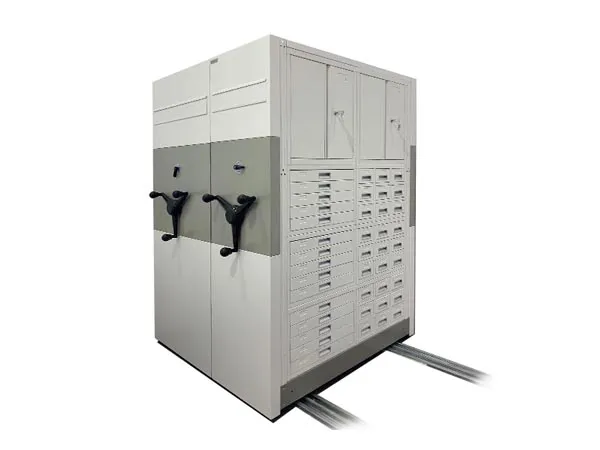
Shelving Material
-
Steel: Many mobile storage shelves are constructed using steel. Steel is a durable and robust material that provides strength to the shelves, allowing them to support heavy loads.
-
Aluminum: In some cases, aluminum may be used for its lightweight properties. While not as heavy-duty as steel, aluminum can still offer strength and resistance to corrosion.
Shelving Surfaces:
-
Laminates: Shelves may feature laminated surfaces for a smooth and easy-to-clean finish. Laminates can also add an aesthetic touch to the shelving system.
-
Powder Coating: Steel components are often powder-coated for enhanced durability, corrosion resistance, and an appealing finish.
Frame Structure:
-
Steel Frames: The frames that support the shelves are typically made of steel for stability and load-bearing capacity.
-
Rolling Mechanism: Mobile storage shelves often have a rolling or sliding mechanism that allows them to be easily moved along tracks. This mechanism may include wheels or bearings for smooth mobility.
Tracks and Rails:
-
Steel Tracks: The tracks or rails on which the mobile shelves move are commonly made of steel. These tracks are crucial for the smooth and efficient operation of the mobile shelving system.
Handles and Controls:
-
Ergonomic Handles: Handles for moving and accessing the shelves are often designed to be ergonomic for ease of use. They may be made of materials such as plastic or rubber for a comfortable grip.
-
Control Mechanisms: Mobile storage systems may include controls for locking, unlocking, and moving the shelves. These controls are usually designed to be user-friendly.
Finishing and Coating:
-
Anti-corrosion Coating: Steel components may have anti-corrosion coatings to protect them from rust and other environmental factors.
-
Paint or Finish: Aesthetic considerations may involve painting or finishing the steel components to match the overall design or color scheme.
Adjustability:
-
Adjustable Shelves: Some mobile storage shelves allow for shelf height adjustment to accommodate different types of items or changing storage needs.
Safety Features:
-
Locking Mechanisms: Mobile storage shelves often include locking mechanisms to secure the shelves in place when needed, preventing unintentional movement.
-
Safety Sensors: Some systems may feature safety sensors to detect obstacles or obstructions in the path of moving shelves, ensuring safe operation.
Mobile Storage Shelves Type
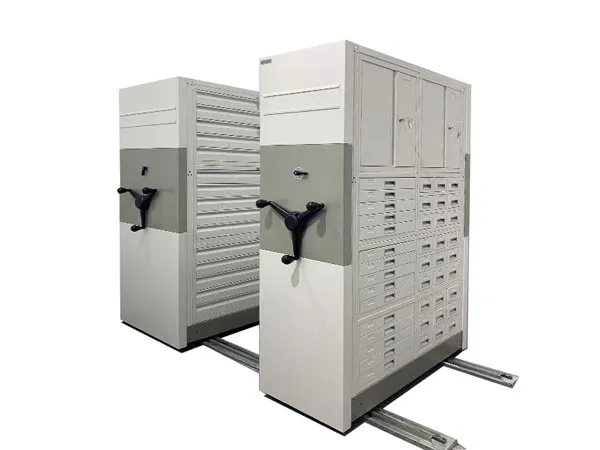
Mechanical Assist Mobile Shelving:
-
Description: These systems use a mechanical mechanism, usually a hand crank or a rotating handle, to move the shelving units along tracks.
-
Advantages: Manual operation allows for precise control over shelf movement, and it doesn't require power sources.
Electrically Powered Mobile Shelving:
-
Description: These systems are equipped with electric motors that move the shelves with the push of a button or through a control panel.
-
Advantages: Electrically powered systems are more convenient for larger installations, heavy loads, or when frequent access is required.
High-Density Mobile Shelving:
-
Description: Designed for high-density storage, these systems maximize space utilization by eliminating fixed aisles. Mobile units are compacted together, and an aisle is created only when needed.
-
Advantages: Efficient use of space, especially in areas where space is limited or expensive.
Manual Push-Pull Mobile Shelving:
-
Description: Users manually push or pull the shelving units along tracks to access stored items.
-
Advantages: Simple design, cost-effective, and suitable for smaller installations.
Wireless-Controlled Mobile Shelving:
-
Description: These systems use wireless controls or mobile apps to move the shelves, providing a modern and convenient way to access stored items.
-
Advantages: Wireless control adds flexibility, allowing users to move shelves without direct physical contact with the system.
Modular Mobile Shelving:
-
Description: Modular systems allow for the customization of shelving configurations and can be easily expanded or reconfigured as storage needs change.
-
Advantages: Flexibility and adaptability to evolving storage requirements.
Safety Features:
-
Some mobile shelving systems come with safety features such as anti-tip mechanisms, presence sensors, and emergency stop buttons to ensure user safety.
Materials and Finishes:
-
Mobile storage shelves can be constructed from various materials, including steel, aluminum, or other alloys. The shelves may have different finishes, such as powder coating, to enhance durability and aesthetics.
Mobile Storage Shelves Features
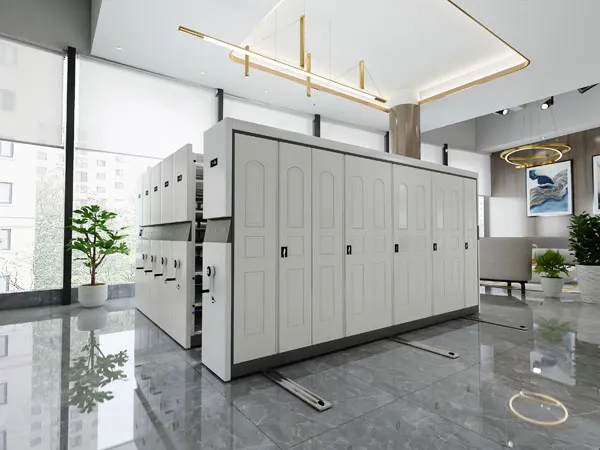
Mobility: Mobile storage shelves are equipped with wheels or casters that allow easy movement and repositioning. This mobility is especially useful in environments where the layout may need to be adjusted frequently to accommodate changing storage needs.
Locking Mechanism: Some mobile shelves come with locking mechanisms to secure the shelves in place once they are positioned. This ensures stability and prevents unintentional movement, especially in busy or high-traffic areas.
Adjustable Shelves: The ability to adjust the height of shelves is a key feature. This adaptability allows users to customize the storage space to accommodate items of various sizes and shapes.
Modular Design: Modular mobile storage systems often consist of interchangeable components, making it easy to customize the shelving unit according to specific storage requirements. This modular design facilitates scalability and flexibility.
High Weight Capacity: Mobile storage shelves are designed to handle a significant weight load. This is particularly important in industrial and commercial settings where heavy or bulky items need to be stored.
Durability: Materials used in the construction of mobile storage shelves are typically durable and resistant to wear and tear. Common materials include steel, aluminum, or high-quality plastics.
Anti-Tilt Mechanism: Some mobile shelving systems are equipped with anti-tilt mechanisms to prevent the shelves from tipping over when fully loaded. This enhances safety in the workplace.
Ease of Assembly: Many mobile shelving units are designed for easy assembly without the need for specialized tools. This makes it convenient for users to set up and adjust the shelving system as needed.
Powder-Coated Finish: A powder-coated finish provides a protective layer on the shelves, preventing corrosion and enhancing the overall durability of the unit. It also contributes to a clean and professional appearance.
Versatility: Mobile storage shelves are versatile and can be used in various settings, including offices, warehouses, libraries, healthcare facilities, and more. They can accommodate different storage needs, from office supplies to industrial equipment.
Accessibility: Mobile shelves are designed for easy access to stored items. Some systems include features like pull-out shelves, sliding doors, or open shelving designs to make it convenient for users to reach and retrieve items.
Customization Options: Manufacturers may offer customization options such as color choices, additional accessories (e.g., dividers, bins, labels), and different sizes to meet specific user preferences and requirements.
Mobile Storage Shelves Application
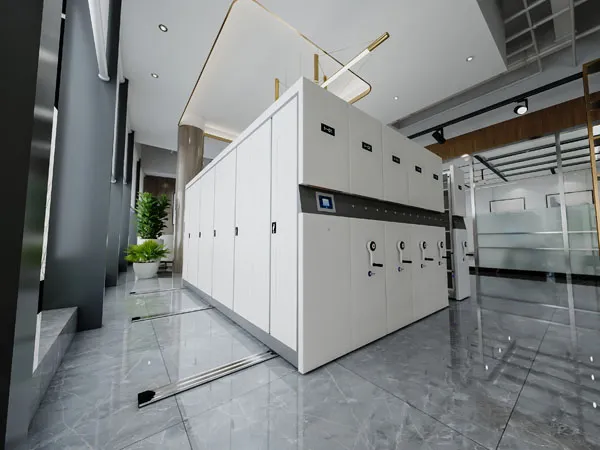
Retail and Inventory Management:
-
Mobile storage shelves can be used in retail environments to organize and store inventory efficiently.
-
Employees can move the shelves around to optimize floor space or quickly rearrange the layout based on seasonal changes or promotions.
Warehouse Storage:
-
In warehouses, mobile shelves are valuable for storing and organizing goods. They can be moved to accommodate changes in inventory or to streamline the picking and packing process.
-
Mobile shelving systems maximize storage density by reducing the need for fixed aisles.
Library and Archival Storage:
-
Libraries and archival facilities can benefit from mobile storage shelves for organizing and storing books, documents, or artifacts.
-
The shelves can be compacted when not in use, saving space and providing easier access to stored items.
Medical and Healthcare Facilities:
-
Hospitals, clinics, and other healthcare facilities use mobile shelves to store medical supplies, records, and equipment.
-
The flexibility of mobile shelves allows for easy reconfiguration to adapt to changing storage needs in healthcare environments.
Office Environments:
-
Mobile shelves in office settings provide a flexible solution for storing office supplies, documents, and other items.
-
They can be moved to create collaborative spaces, temporary workstations, or to adapt to changes in office layouts.
Museum Collections:
-
Museums often use mobile storage shelves to store and organize their collections efficiently.
-
These shelves can be moved to create space for exhibitions, and the compact design helps protect valuable artifacts when not on display.
Educational Institutions:
-
Schools and universities can use mobile storage shelves for organizing educational materials, textbooks, and supplies.
-
The flexibility allows for easy adaptation to changing classroom needs.
Industrial Applications:
-
In manufacturing or industrial settings, mobile storage shelves can be used to store tools, parts, and equipment.
-
The ability to move shelves helps optimize workflow and improve efficiency.
Architectural and Design Studios:
-
Studios involved in architecture or design may use mobile storage shelves for organizing design materials, blueprints, or project-related items.
-
The mobility allows for easy reconfiguration of the workspace as project requirements change.
Garage or Workshop Storage:
-
Home garages or workshops can benefit from mobile storage shelves to store tools, supplies, and equipment.
-
The ability to move shelves makes it easier to create space for various projects.
Mobile Storage Shelves Maintenance
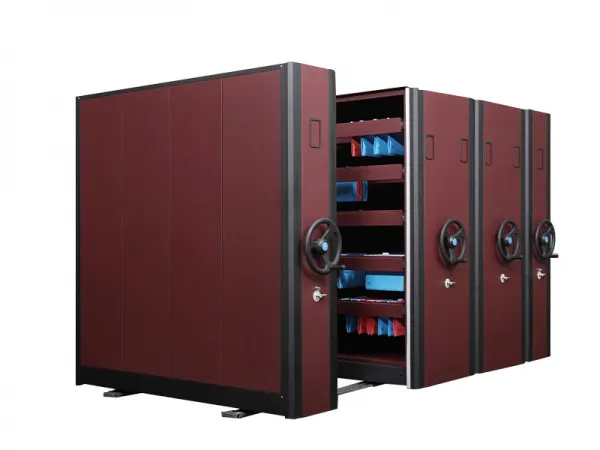
Regular Cleaning:
-
Dust and clean the shelves regularly to prevent the accumulation of dirt and debris.
-
Use a mild cleaning solution and a soft cloth to wipe down the surfaces. Avoid abrasive cleaners that can damage the finish.
Inspect for Damage:
-
Regularly inspect the shelves for any signs of damage, such as bent or broken parts.
-
Check the wheels, tracks, and other moving parts to ensure they are functioning smoothly.
Lubrication:
-
Lubricate moving parts, such as wheels and tracks, periodically to ensure smooth operation.
-
Use a lubricant recommended by the manufacturer to prevent friction and reduce wear.
Tighten Loose Components:
-
Check for loose bolts, screws, or other fasteners and tighten them as needed.
-
Pay attention to any wobbling or instability, as this could indicate loose components.
Weight Distribution:
-
Be mindful of the weight distribution on the shelves. Avoid overloading them beyond their recommended capacity.
-
Distribute weight evenly to prevent strain on specific areas of the shelves.
Check Safety Features:
-
If your mobile storage shelves have safety features such as locking mechanisms, ensure they are functioning correctly.
-
Test any safety locks or brakes to make sure they engage properly.
Train Staff:
-
If the mobile storage system is used in a workplace, make sure that staff members are trained on proper usage and maintenance procedures.
-
Encourage reporting of any issues or malfunctions promptly.
Temperature and Humidity Control:
-
Maintain a stable environment to prevent damage caused by extreme temperatures or humidity.
-
Avoid exposing the shelves to direct sunlight, as this can cause fading or warping.
Handle with Care:
-
Encourage users to handle items with care when loading or unloading the shelves.
-
Avoid slamming or forcing the shelves, as this can lead to damage.
Follow Manufacturer Guidelines:
-
Adhere to the manufacturer's guidelines and recommendations for maintenance and usage.
-
Keep the user manual handy for reference.
Emergency Preparedness:
-
Have a plan in place for emergency situations, such as power outages or equipment malfunctions.
-
Train staff on emergency procedures, including how to manually operate the shelves if necessary.
Mobile storage shelves are chosen for their flexibility, efficiency, and adaptability to dynamic storage requirements. They offer a practical solution for maximizing space and improving accessibility in various settings.




